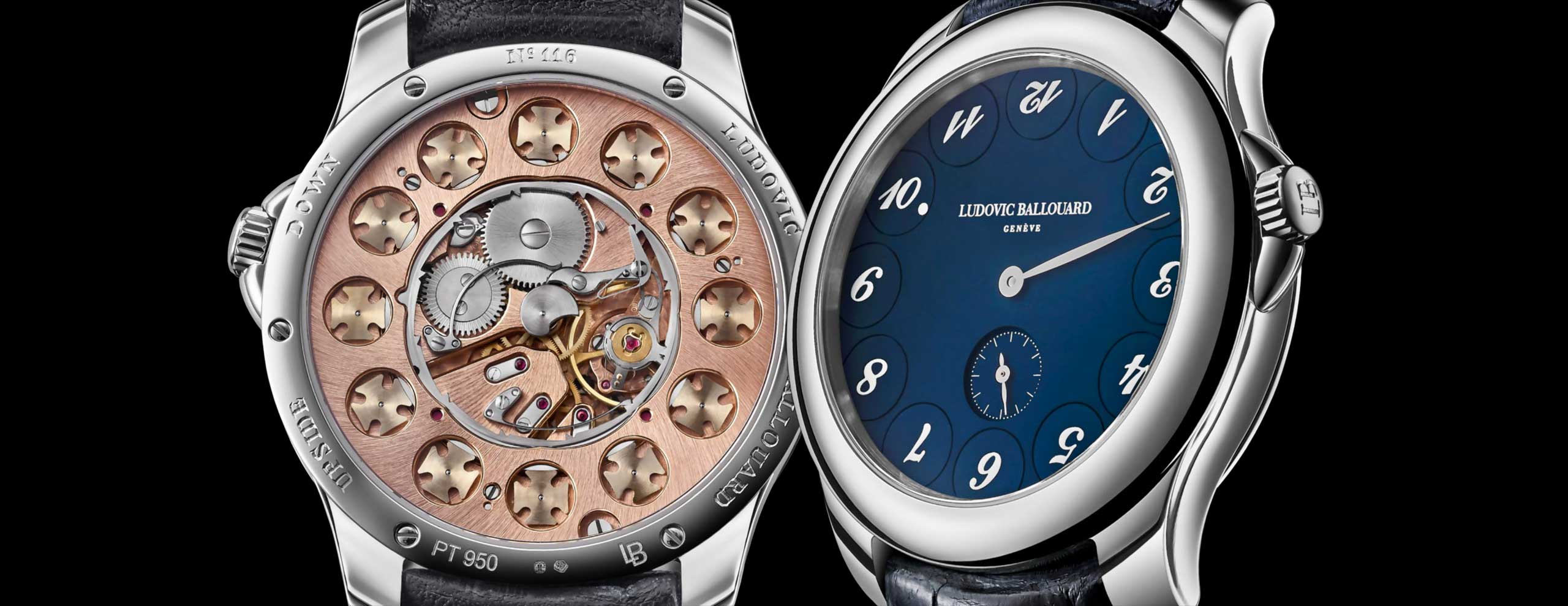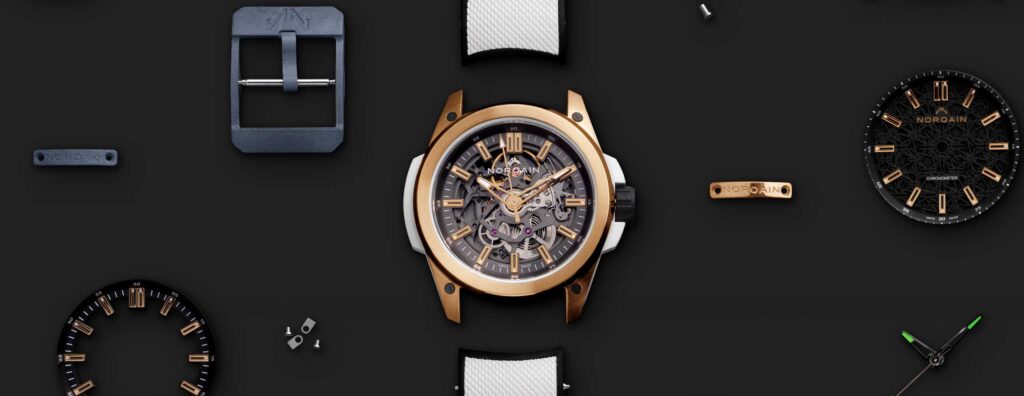The elegant brilliance behind Ludovic Ballouard’s famed poetic complication.
The field of fine watchmaking can be divided into two main segments — complicated watches in which mechanical complexity is pursued as a form of art or high precision timekeepers that uphold the legacy of scientific inquiry. However, there are outliers that depart entirely from these defining narratives, where mechanics are put at the service of aesthetics for entertainment value, as a natural outgrowth of mechanical watchmaking as less of a necessity.
Starting in 2000, this particular wave of watches emerged, predominantly from independent watchmakers, defying horological history which, in broad strokes, has been defined by the principle of function dictating form. Although decades have passed since, there are some watches that still remain so unique in their emotional commitment to how we perceive and try to capture time that they are worth revisiting. One of these watches is the Upside Down by Ludovic Ballouard, a former watchmaker at F.P. Journe who, in the thick of the financial crisis in 2009, decided to set out on his own and created a watch that would emphasize the importance of the present.
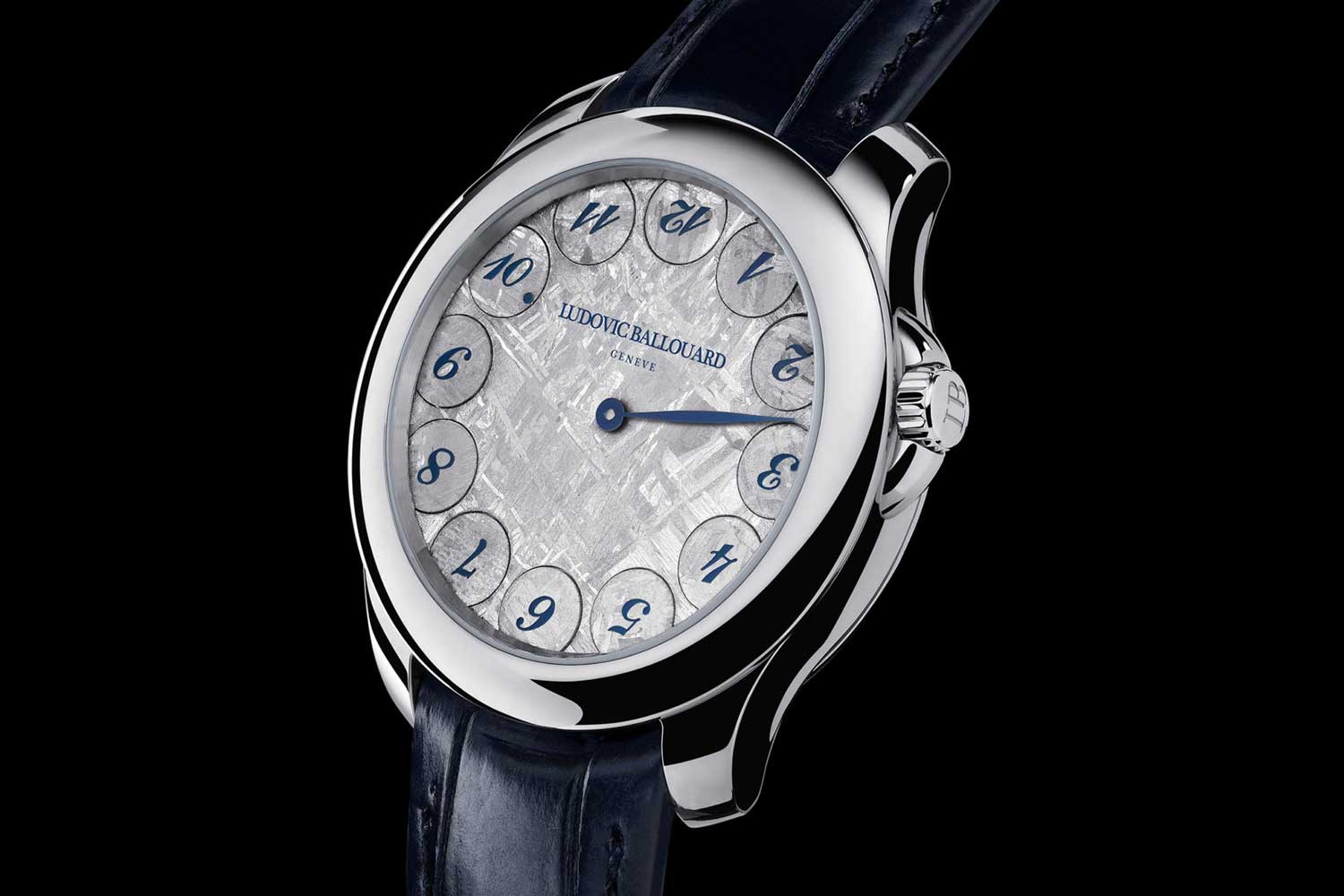
A unique Upside Down in platinum with a meteorite dial
Amidst the global media buzz surrounding the stock market crash, where a relentless flow of declining figures dominated the headlines, Ballouard contemplated the notion that even if just a single figure had the strength to defy the downward trend and stand tall, it would be sufficient to sustain the momentum of life itself. Thus, with the exception of the current hour, the remaining 11 numerals on the dial of the watch are consistently positioned upside down, additionally serving as a reminder of the limited influence we have over the past and future.
To ensure that the 12 hour markers could independently rotate on their axes and stay in place regardless of the watch’s orientation, it would have been necessary to employ 12 torsion springs and 12 snapping jumpers. However, this approach would have demanded excessive energy for such a small movement. Furthermore, the inclusion of 12 pivotable components already reduces the available space for the mainspring barrel, naturally making it smaller than that of a regular movement with the same dimensions. Thus, Ballouard decided to implement the Maltese cross system.
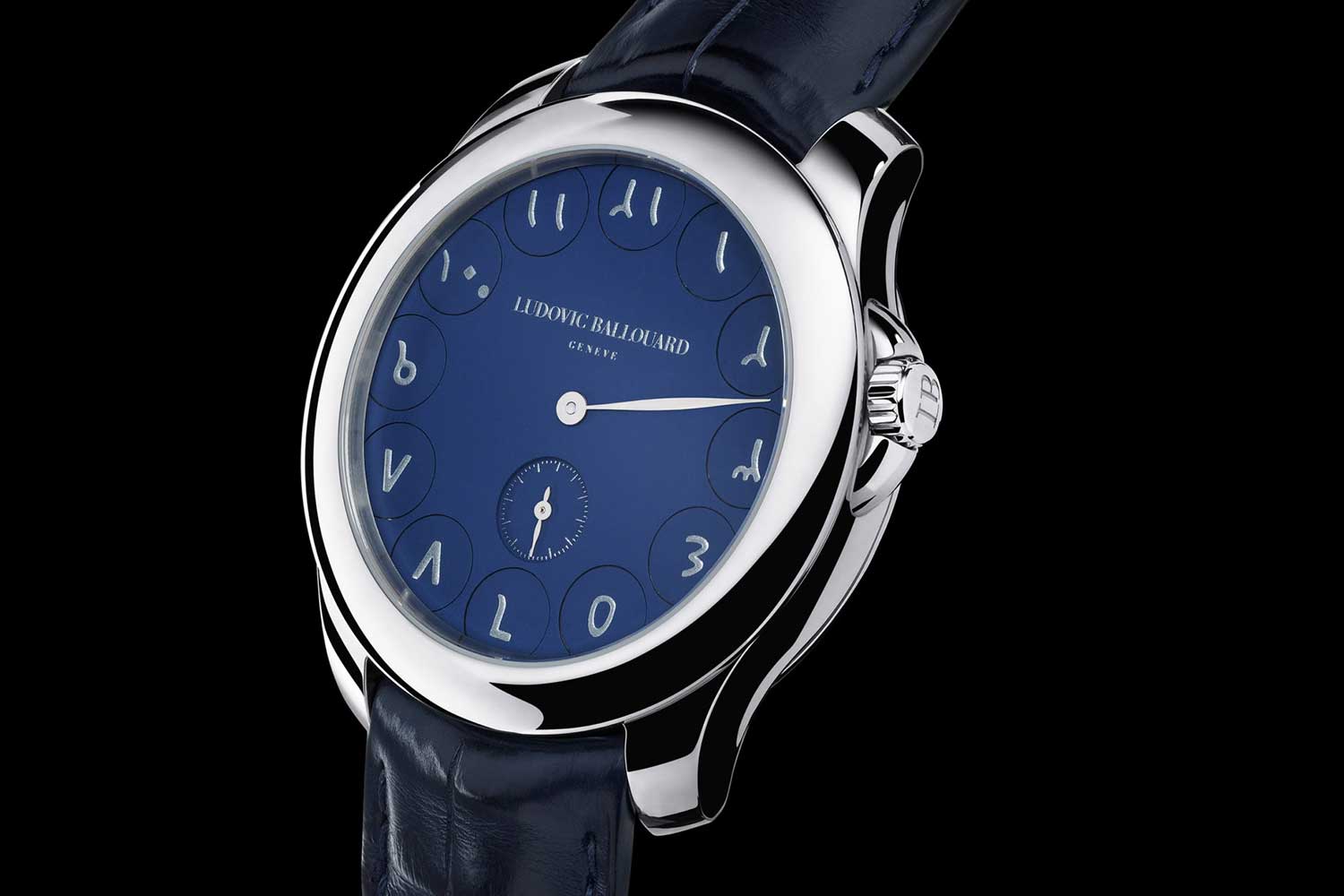
An Upside Down with small seconds and Hindu Arabic numerals
A Change of Perspective: Ludovic Ballouard Caliber LB01
The movement is the hand wound LB01 that was developed in-house. Its wheel train design is based on the Peseux 7001. Evidently, the entire architecture of the movement had to be designed and produced from scratch, so that the baseplate and bridges can accommodate the Maltese cross mechanism that is not a module but completely integrated in the movement. The wheel train is encircled by 12 Maltese crosses to which the hour markers are affixed. This differs from the Opus XIII that Ballouard developed for Harry Winston in 2013, as the latter had a much smaller movement and thus utilizes six-point star wheels instead of Maltese crosses. As the hour numerals have to perform a 180° rotation at the top of each hour, an even number of branches or points is required in both instances.
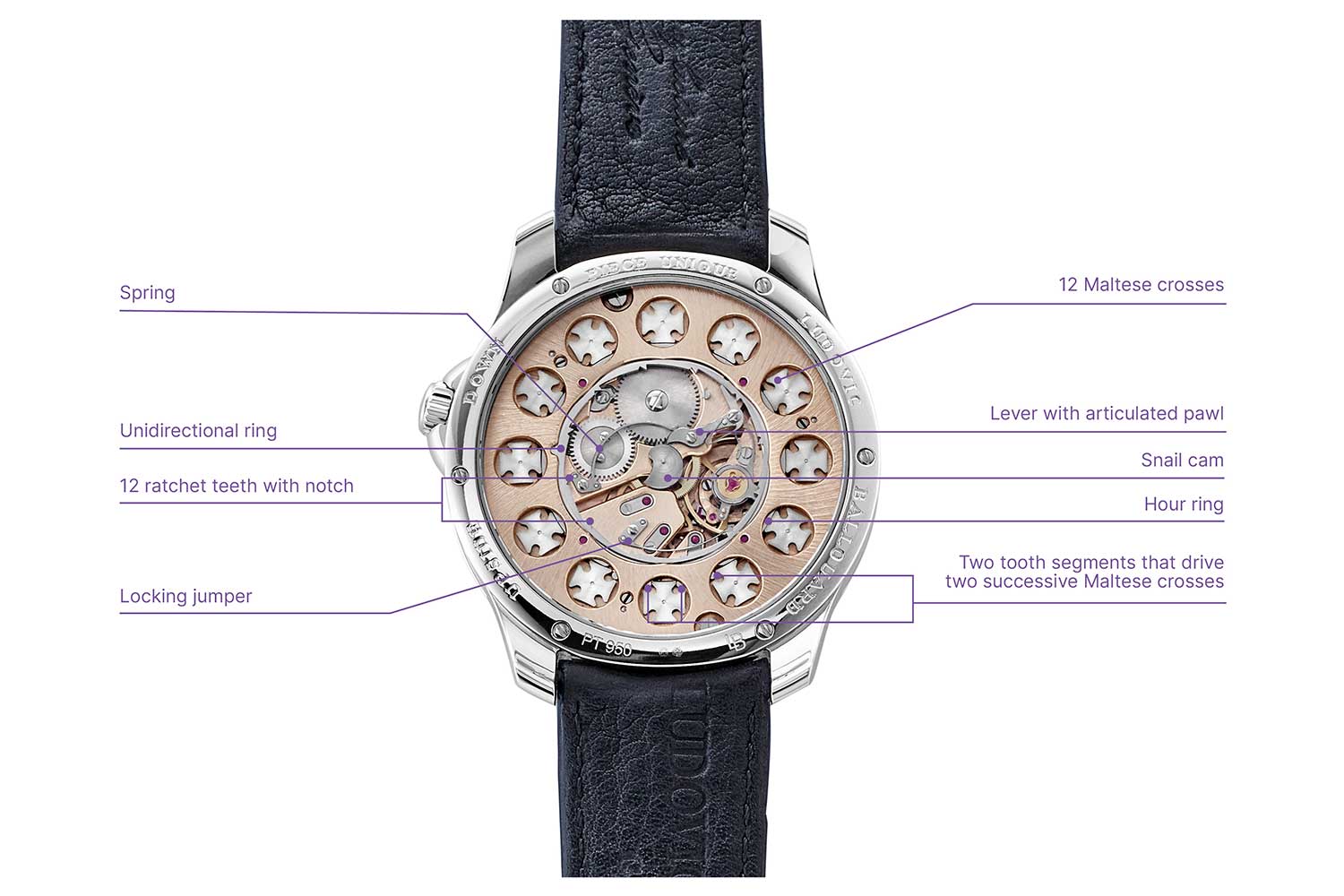
The Maltese cross jump hour mechanism driven by the center wheel
In watchmaking, Maltese crosses are more commonly used as a stopwork mechanism, preventing the watch from reaching the less optimal portion of the torque curve, or as a component that encodes the leap year in a perpetual calendar. In both instances, they fulfil a vital role in the function of a watch. But in the Upside Down, 12 of them are applied to achieve a purely aesthetic, emotionally evocative representation of time, for which a patent was granted.
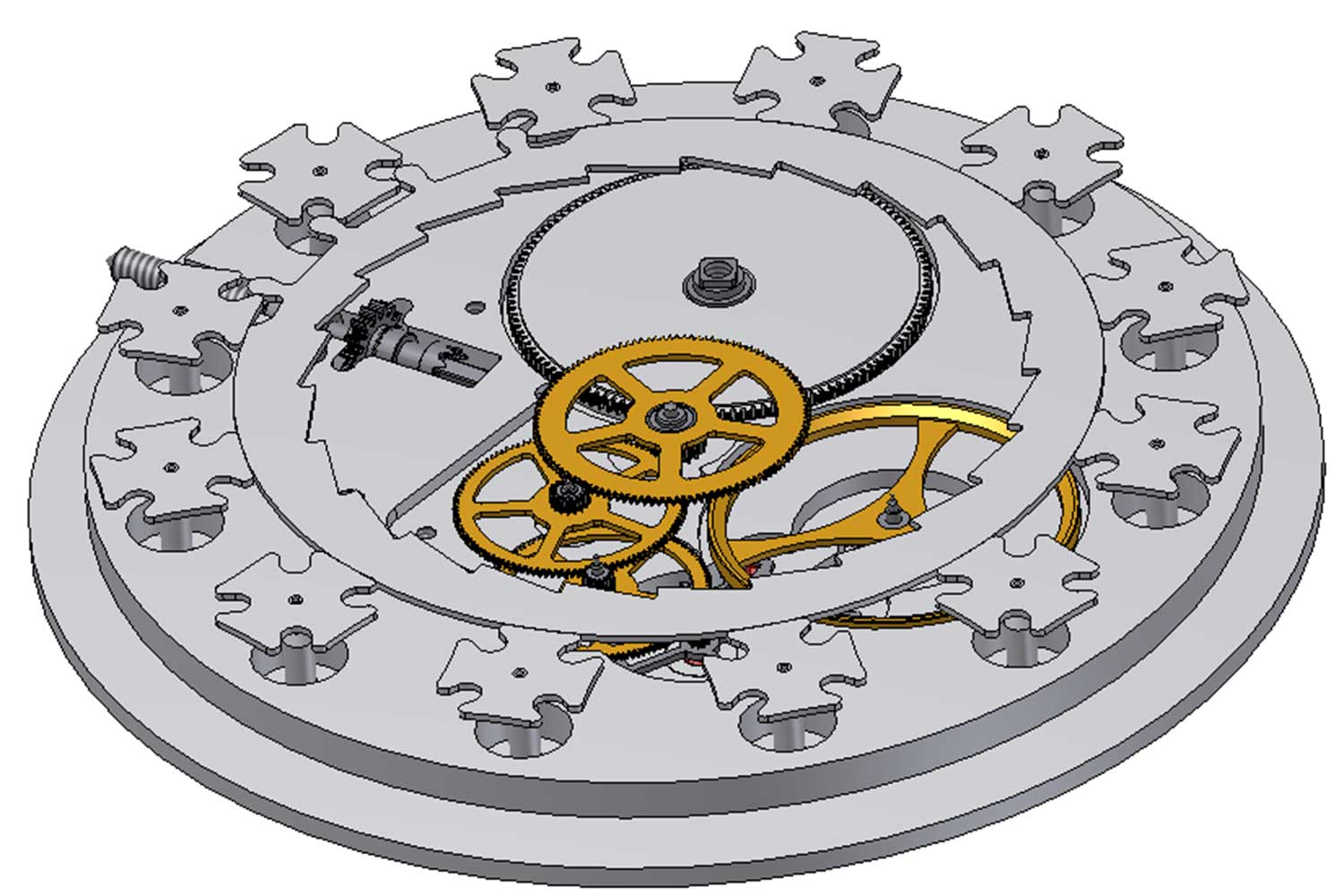
A rear view of the movement with the bridges and jumping mechanism removed. The unidirectional hour ring features internal ratchet tooth each controlling a rotation of 30 and four external teeth to drive two consecutive Maltese crosses at a time
The entire display mechanism is driven by the center wheel as it makes a full rotation every 60 minutes. A snail cam, rotatably mounted on the center wheel’s pivot, is sampled by a lever with a pawl arm. The lever is held under the tension of a spring and accumulates power during its ascending arc, and as it falls off the highest point of the cam and lands on the lowest, its pawl end drives a ring with internal ratchet teeth, advancing it by 30°. This ring is also designed with four external teeth so that it is able to drive two consecutive Maltese crosses such that at the top of the hour, the previous hour numeral performs a 180° rotation downwards and the next hour rotates by the same value upwards. By having four teeth arranged at a pitch diameter six times that of the Maltese cross, the mechanism allows the Maltese cross to rotate by an angle equivalent to two successive half-turns.
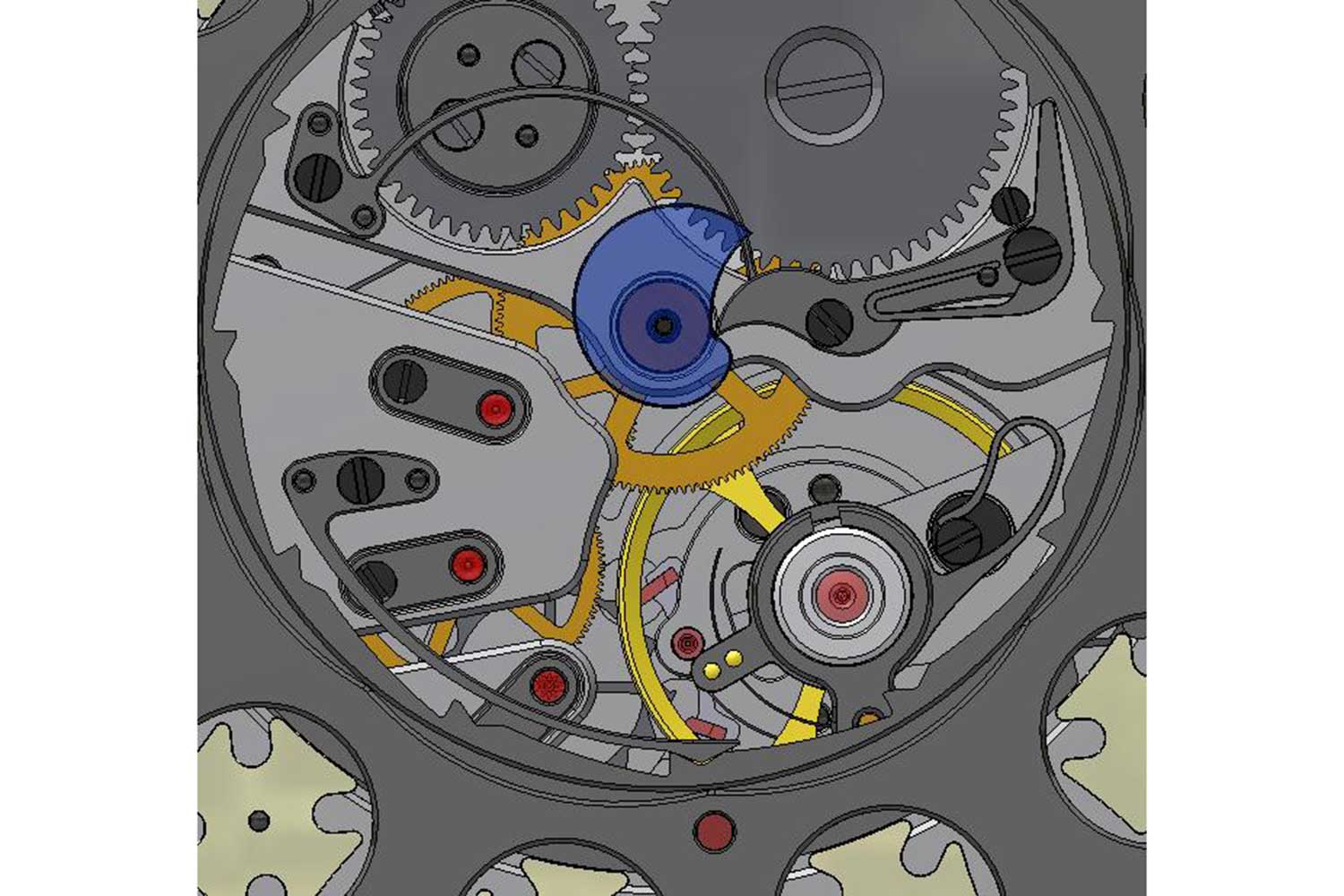
A snail cam, driven in rotation by the center wheel, is sampled by a lever that is held under the tension of a spring. It accumulates power during its ascending arc and as it falls off the highest point of the cam and lands on the lowest, its pawl end drives a ring with internal ratchet teeth, advancing it by 30°
The specific ratio of 1 to 6 between the pitch diameter of the toothed ring and each Maltese cross is chosen to match the relative angular rotations of these components. The toothed ring, being larger in size, allows for the desired rotational movement of the Maltese cross, with each ratchet tooth controlling a rotation of 30°, while the Maltese cross itself rotates by 180°. A sight to behold in person, the synchronized rotation of two consecutive digits occurs instantaneously, thanks to the gradual buildup of potential energy in the spring, accumulating during the revolution of the minute hand over a span of 60 minutes. Subsequently, this energy is swiftly released by the cam.
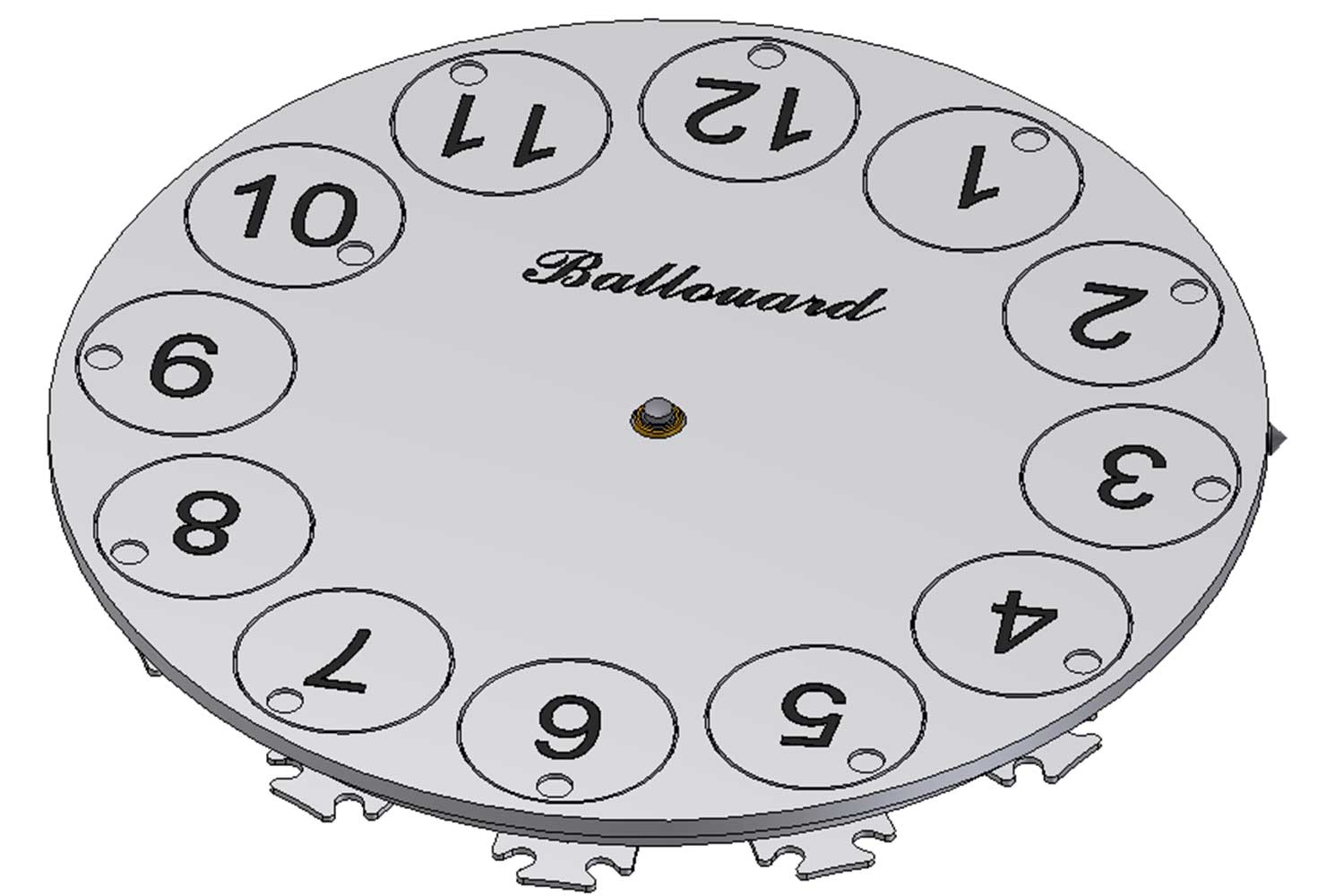
The 12 Maltese crosses are directly attached to 12 circular inlaid hour markers
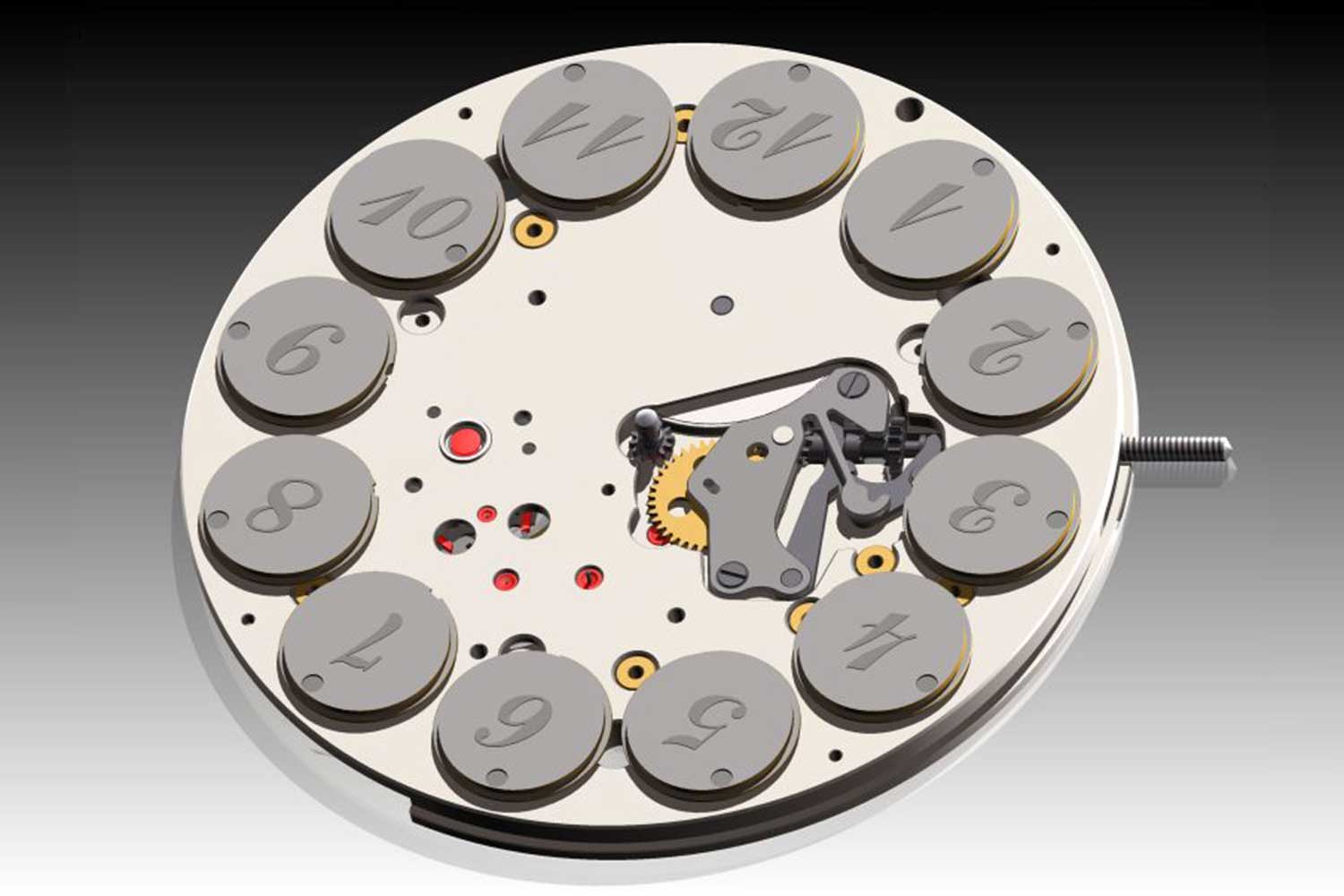
The cannon pinion in this case only holds the pivot of the center wheel and drive the minute wheel.
The movement has a diameter of 35mm and consists of 228 parts. When cased up, the watch measures 41mm wide with a slim height of just 11mm. The case is entirely polished such that it doesn’t detract from the unique time display. It features wide lugs with a pronounced curvature, enabling it to sit low and close to the wrist.
Over the last 14 years, the Upside Down has been produced in numerous limited and bespoke editions, featuring a variety of stone dials including mother-of-pearl, meteorite, lapis lazuli and aventurine. However, they have been produced in exceptionally small quantities, typically under 10 pieces per limited edition, making them an extremely rare sight overall despite the variety. Today, Ballouard produces only 25 pieces a year in addition to his other watch, the Half Time, of which a mere five units are made a year.
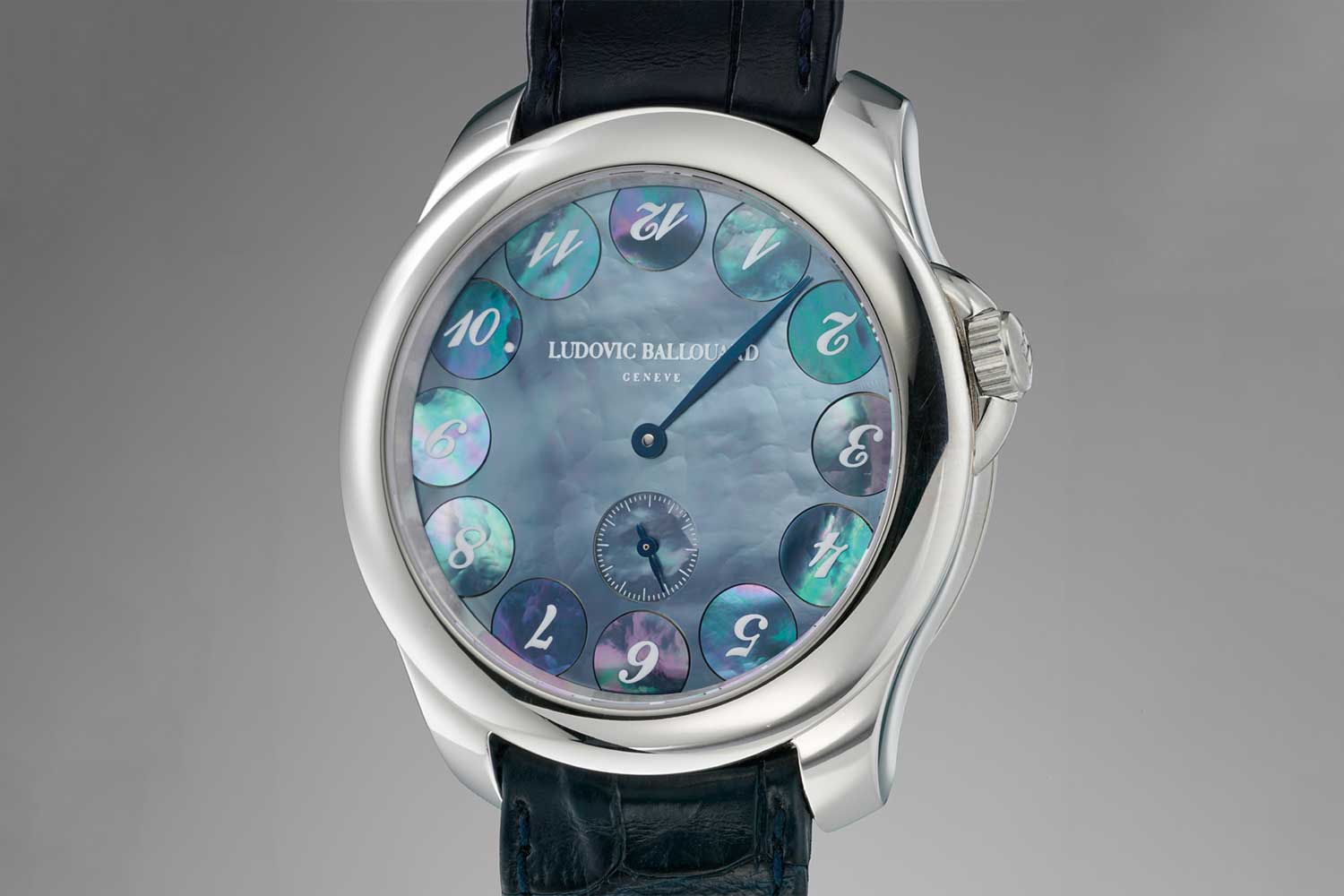
A unique platinum example with a stunning blue mother-of-pearl dial (Image: Phillips)
As far as unconventional displays go, few can rival the subtle charm of the Upside Down. At a cursory glance, it masquerades as a standard time-only watch, but upon closer inspection, its sheer technical whimsy and philosophical aspirations come to light. It is one of those rare instances that a watch not only transcends its utility as a watch, but also becomes a subtle exploration of our relationship with time itself. For that and the fact that it can be had in totally unique and exotic variations, it’s definitely worth pursuing.












